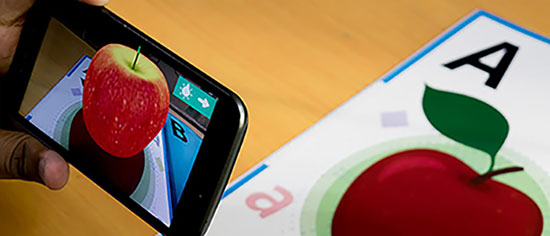Augmented Reality
It’s not easy to engage students in the real world and provide condition for their interaction with real elements while teaching. Although the nature and surroundings are basically three dimensional, we prefer to use two dimensional media such as paper and board, which are more familiar, easy, flexible and cheaper for us
On the other hand, it’s possible to use virtual 3D environment generated by computer that are more attractive and entertaining. But providing such a condition requires the provision of computers with high graphics processing power and therefore a high price. For this reason, we propose the use of Augmented Reality technology.
The easier and cheaper alternative solution is to add layers of virtual elements to the actual content of a complex and difficult subject, as a result of the existence of this virtual information, the user’s understanding of the subject Significantly increase.
As example of this, it is possible to train the complex surgical operation but in the actual operating room.
An Augmented Reality allows the real-world objects to be combined or completed with virtual elements.
So ideally, the use of this technology convey the sense to the user to feel the virtual elements exactly in the same space as the real objects are.
This technology is not limited to the sense of sight and can be applied to other senses such as hearing, touch and even smell; It means elements that are used in Augmented Reality can include text, image,video, sound, 3D models and animation.

The differences between Augmented Reality and Virtual Reality
One thing to notice is that this technology should not be considered the same as Virtual Reality technology. Virtual Reality technology and Augmented Reality technology are two distinct concepts that have major differences.
In AR, the user gets integrated virtual content with real content, while in VR technology, the user is immersed in a simulated environment. Perhaps this is why some researchers in this field, call Virtual Reality as ‘full immersed’ and call Augmented Reality as ‘half immersed’.
Regarding the features of this technology for education, this technology helps students explore and search real world with the help of virtual elements such as text,video,animation and image as complementary elements.
Indeed, one of the most common uses of AR is the interpretation and understanding of the available real space with the help of a layer from the location-based information.
On the other hand, AR technologies can help integrate real and virtual learning resources.
In other words, this technology can provide the conditions for students to experience scientific phenomena that are not actually possible to experience them in reality; For example the observation of the solar system by students on their desk or imagination the process of photosynthesis in front of them.
The pajuhesh co as the first producer and developer of AR-based products and one of the leading companies in producing applications using this technology in other areas such as industry, tourism, advertising, market and… are ready to accept a variety of orders in this area.

